Forsooth, I hath made the journey down to yon local smithee, and picked up this.
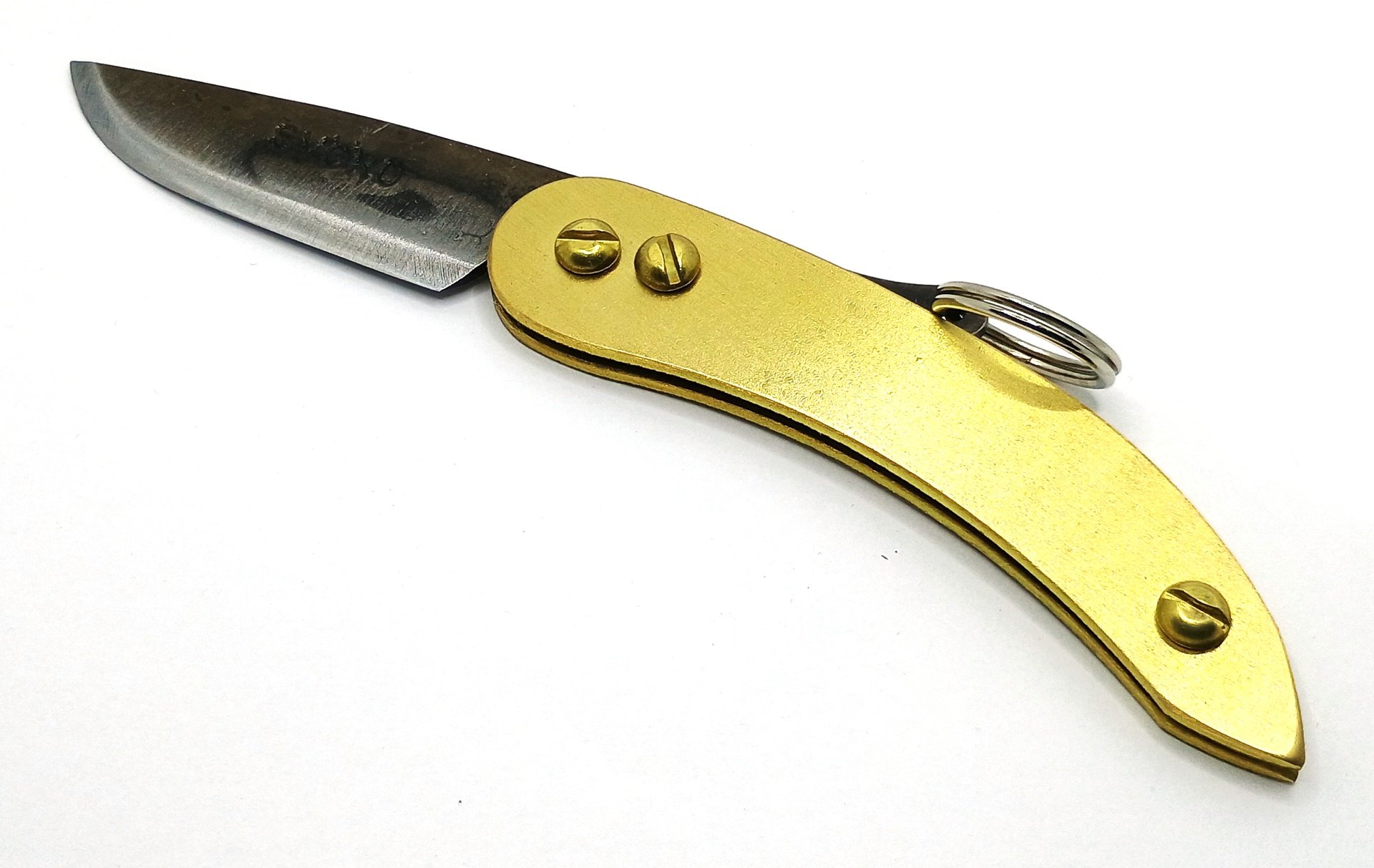
I think no discussion of cutlery is complete without eventually, at some level, touching upon the Svörd Peasant series. To label this knife as a “classic” probably doesn’t quite go far enough. The Peasant is a crocodile; a veritable relic, unchanged in its design since antiquity and yet still here today filling its particular niche. In a certain sense this is The Pocketknife, with the capital T and capital P being important.

The Peasant is a tang grip folding knife. It is brutally simple, and its design is a deliberate throwback to what is quite possibly – no hyperbole – one of the oldest known folding knife designs in the world.
The Peasant’s included pamphlet specifies that it’s based on a design observed in Bavaria and Bohemia around the 1600’s. However, there are documented examples of folding knives with similar albeit not identical tang grip designs dating back as far as the time of the Roman empire. The Romans did indeed have folding pocketknives and some of them were quite complex, even including one notable example not too dissimilar from our modern Swiss Army knife, as displayed here. Simple friction folders were obviously where it all began and were exceedingly common for hundreds and hundreds of years. But by 300 AD or so it is purported that examples were appearing with a familiar extended tang design along the lines of what we have here.
The Peasant is intentionally made out of low tech materials using low tech equipment, mostly by hand, by B.W. Baker’s Svörd knife company in New Zealand. It comes in multiple sizes and multiple handle materials, most visibly polypropylene in various colors and also wood. You can get kit versions, too, if you want to have the satisfaction of assembling yours yourself. This is the “Micro” variant, the smallest version on offer, and strap on those goggles and don your top hat – I just had to get the brass version. I mean, of course I did. Come on.
Modern knives have a seemingly endless of supply tricks and mechanisms, and of course we’ve had a grand old time inspecting, dissecting, and discussing many of them in this very column.
The Peasant, however, doesn’t. Its mechanism is purely that it has no mechanism. Only a single pivot point through a hole in the blade, and that’s all. It’s the absolute king of vintagecore. You might think your fountain pen and your pocketwatch and your waistcoat are anachronistic chic, but I’m telling you all that stuff is kindergarten playground time compared to how ancient this thing is.
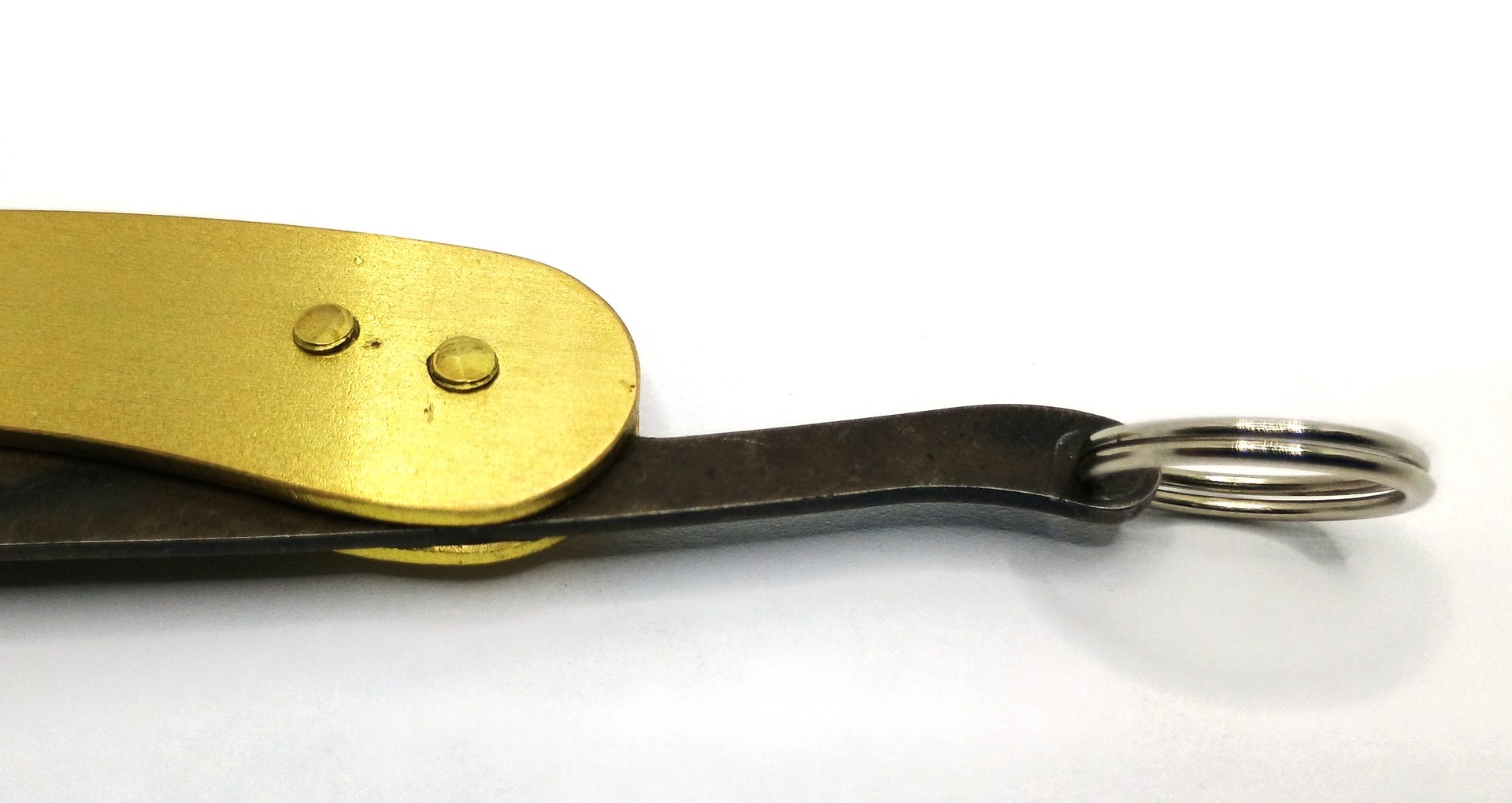
The Peasant’s extended tang serves both as its opener and what holds it open. You’ll note the method is extremely reminiscent of how a classic straight razor works and the lineage between those and this is no doubt shared.
The knife is held together with just three screws, which are literally just commodity brass machine screws that are cut to length after screwing them through the handle and then peened on the ends. One acts as the fulcrum point for the pivot, one serves as the open position endstop, and another one holds the handle together at the tail end. And that’s it. Job done, that’s the whole system completely described.
The Peasant stays open by way of you gripping the tag against the spine of the handle. This method is exceedingly simple but also remarkably secure. As long as you’re holding it firmly the knife won’t close up on you. The tang ends with a little hole which comes with a small split ring in it, via which you could dangle it from your keys or tie on your own lanyard if you were so inclined.
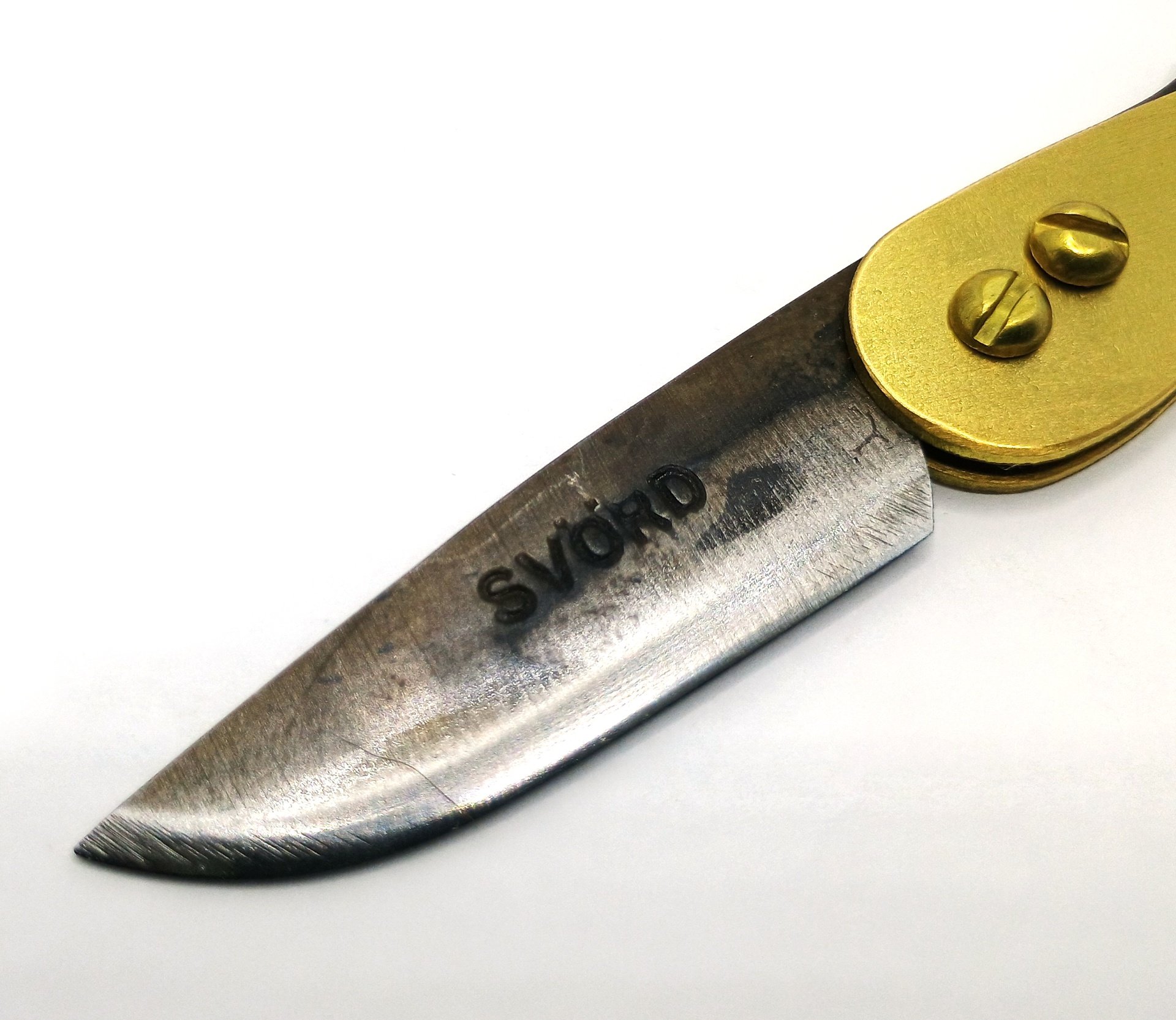
The Peasant’s blade is made of simple 15N20 steel which is not stainless, and takes on this dark patina for maximum medieval cred. You should probably keep it lightly oiled. It has a mildly drop pointed blade with a deep edge grind that’s got no secondary bevel whatsoever. It’s a convex grind a little under a quarter inch deep, and that helps the Peasant with cutting performance and allows it to perform well above its weight class provided the shortness of the blade is not an impediment to what you’re doing.
What, you thought Fällkniven and Bark River developed the convex grind as the hot new ticket? New doesn’t enter into it. All they did was nick it from history.
This Micro variant is quite diminutive, although the tang sticks out by necessity even when it’s shut. That brings the overall closed length to 4-1/16" not including the split ring on the end which flaps around freely in any case. It’s precisely 5" long when open, and its little blade is 1-7/8" long. There is no ricasso so the entire length is a usable edge. There’s a V shaped choil of sorts at the base which is where the endstop screw slots into when the blade is closed.
The blade on mine is 0.057" thick at the spine, although I wouldn’t be surprised to learn there is some variance from piece to piece. Across the handle scales the Micro Peasant is just 0.180" thick not including the heads of the screws. With them, it’s still just about 0.265". You want to talk thin and light? Modern knives wish they could be as little as this. My brass variant is probably the heaviest model of the bunch, but even it is only 41.9 grams or 1.48 ounces, and that includes the keyring because I was too lazy to take it off.
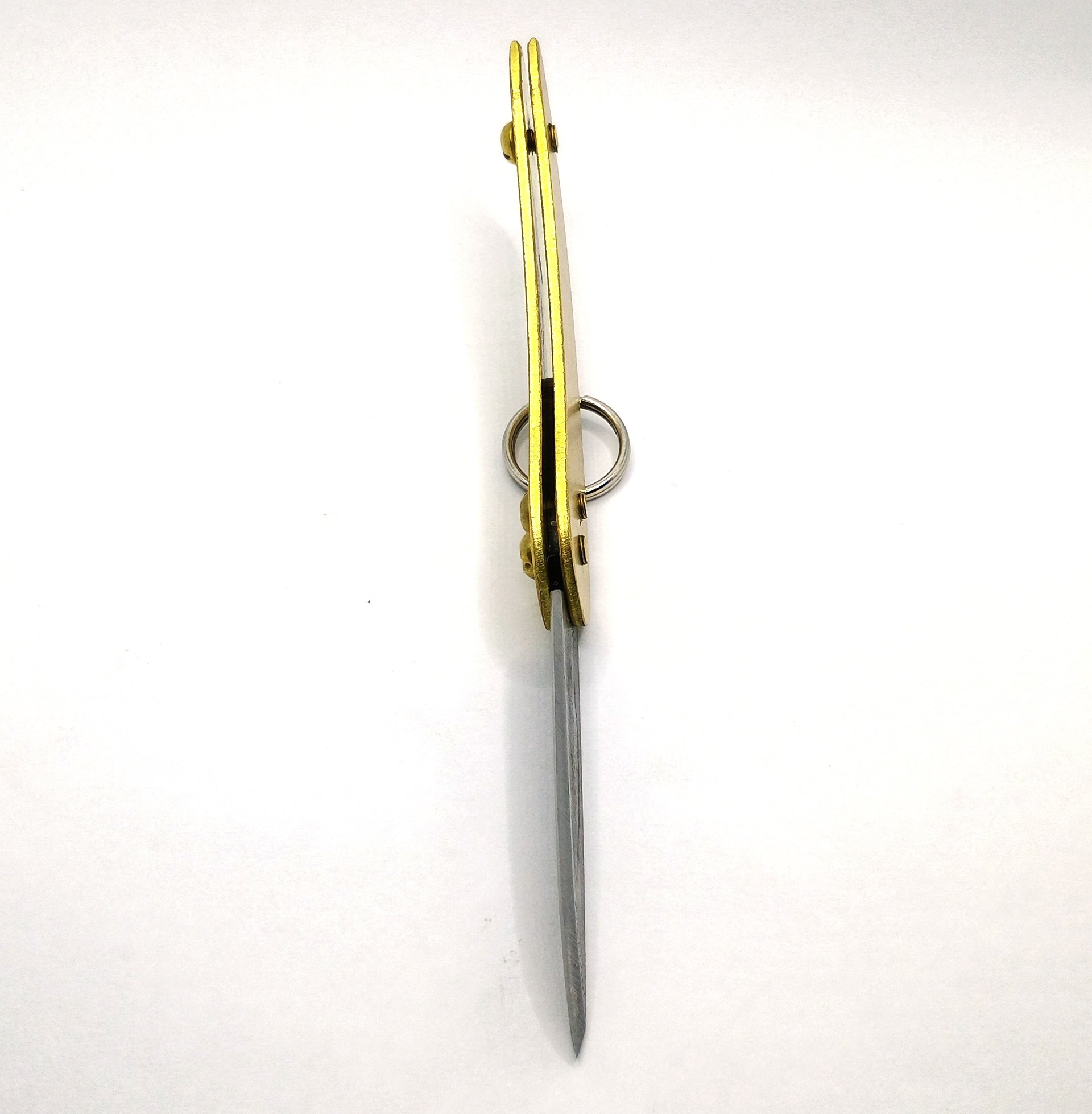
Modern knives may have fancy composite backspacers, or anodized aluminum diabolo barrels, or maybe precision machined washers. These are decadent fripperies. Mere lace and frills. The Peasant, for its part, has no handle spacers whatsoever. That means the blade rubs against the insides of the brass handle plates. And so what if it does? You got a problem with that or something? It turns out, it still works just fine even so. And the brass is softer than the steel, so the handles are absolutely incapable of scratching the blade in any case. Rather, the reverse happens.

The entire bill of materials consists of just seven components, and that’s if you count the split ring. The screws, as mentioned, are just ordinary brass machine screws. Like, from the hardware store. One of the handle plates is threaded and the other one isn’t, and the screws are proof against backing out by having the ends peened into place. This is evidenced by the flat spots on the heads, for instance.
This means the Peasant is actually not quite so simple to take apart as it appears, because backing the screws out ultimately involves overcoming their smashed tips. As you can see, I broke one of the screws getting mine apart for this picture. But it wasn’t a big deal; I had some suitable #6-32 machine screws just lying around on my workbench already. I believe the stock screws were actually originally fine thread #6-40, but it was the work of a few seconds to ream the threads out to 32 pitch with a tap. No harm done, and keep on keeping on.
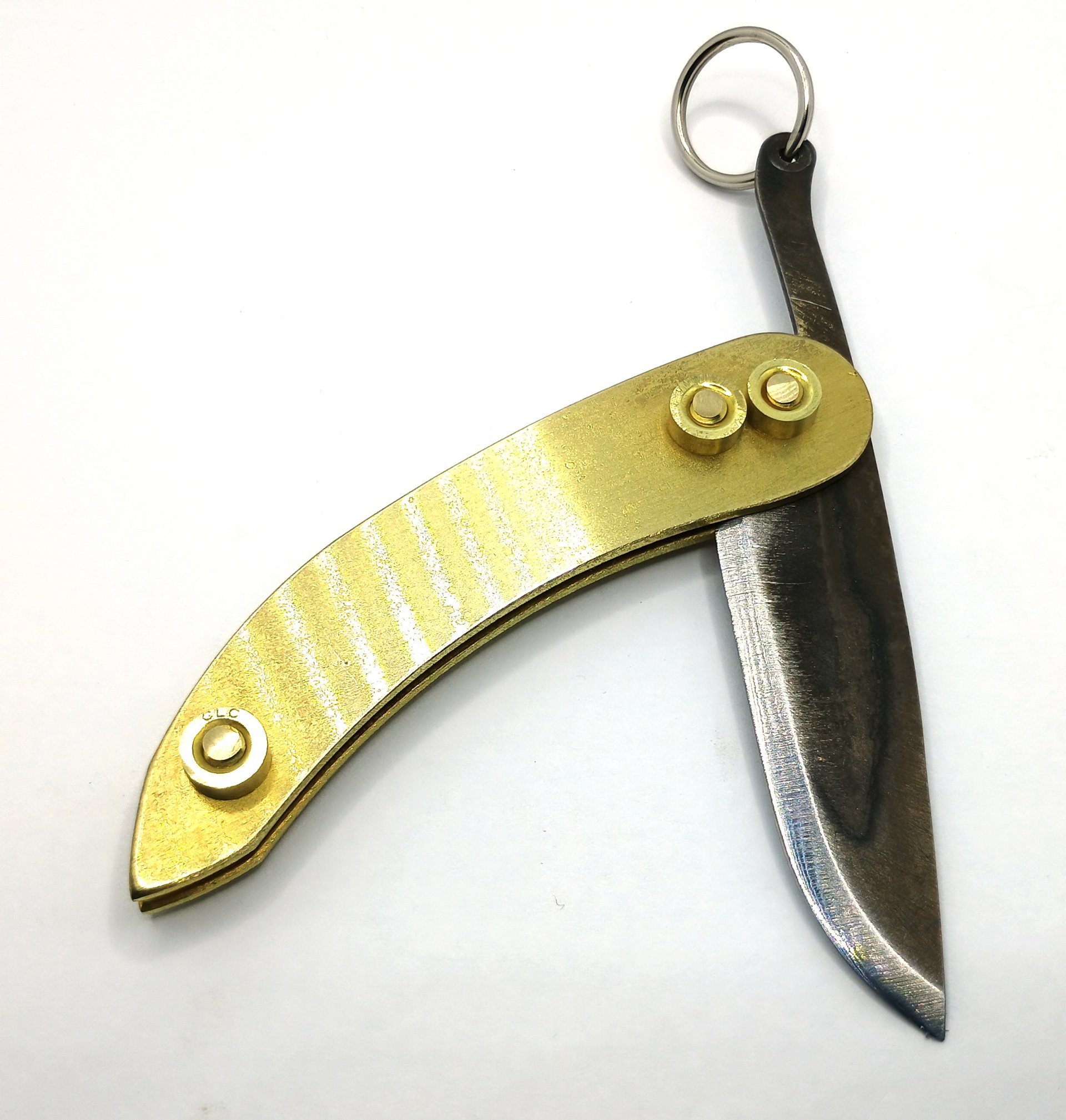
Rather than hammer my new screws and annoy myself further in the future, I instead fabricated these brass jam nuts. In keeping with the spirit of the occasion, I turned them freehand on my bench grinder. The brass Peasant’s handle plates also shine up very nicely with the application of a little Flitz. Although admittedly, probably not for long unless you clearcoated it or something.
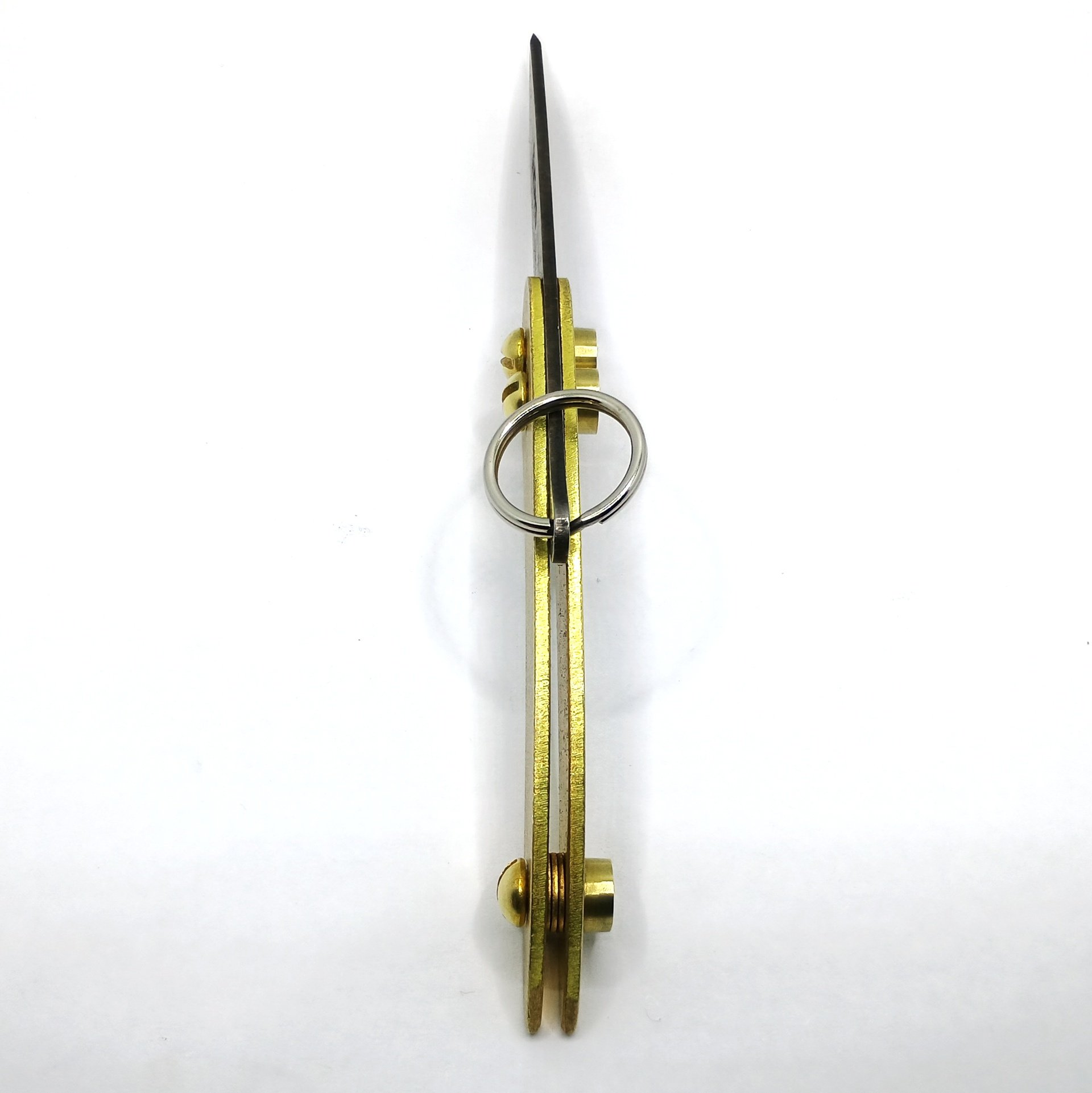
I also found a trio of random brass washers in my odds and ends, which make the perfect tail spacer. This is completely unnecessary, but the beauty of it is you can customize your Peasant like this with just any old trifles and junk you have lying around and it works.
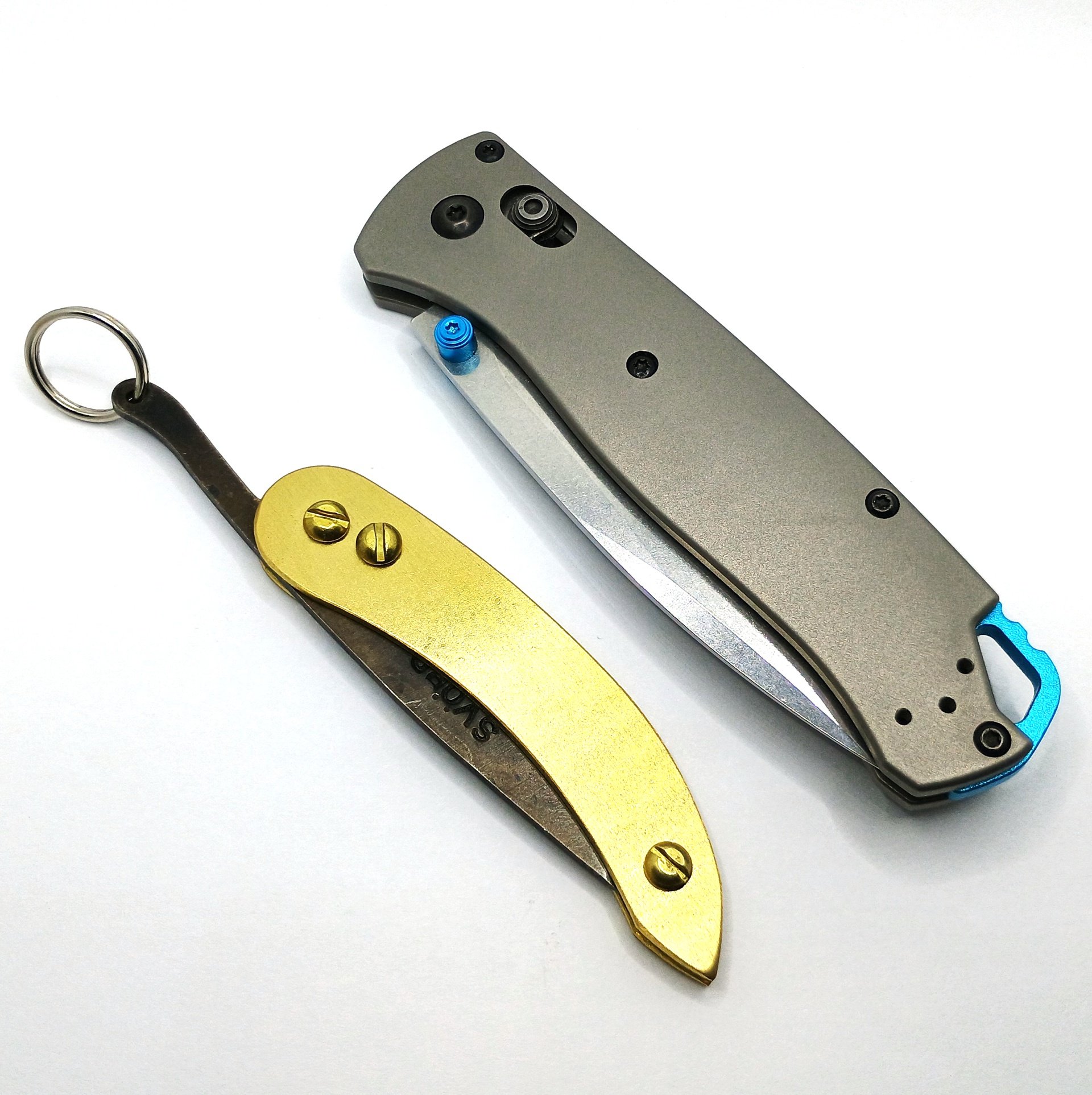
Here’s a very modern knife next to it. This HUAAO Bugout clone may look simple by today’s standards, but its elegance is peanuts compared to the Svörd. The HUAAO is all titanium, anodized aluminum, and stainless steel. Wonder materials. Black magic! The Peasant has, and needs, none of the above. You could hand one to your hypothetical time traveling medieval friend and he would experience no future shock; he’d tell you how it could be made, precisely what out of, and he’d probably even be able to make another one just like it.

Oh yes. And I would be remiss if I did not mention the pamphlet it comes with.
If I haven’t played up the historicity of the Svörd Peasant enough, the pamphlet does it some more. Simplicity is the Peasant’s selling point, and this as well as the knife’s inherent cheapness are driven home all throughout. True to form, the documentation is just printed on regular old paper. Nothing glossy, no bond, not even in color. For your entertainment I’ve scanned both the front and reverse, which are available here and here, respectively.
The bloke with the wedge of cheese is a nice touch. He’s very Phil Foglio.
For his part, B.W. Baker guarantees your Svörd for life. There are some included care tips as well, the highlight of which being the sharpening tips which boil down to basically, “Use a stone on it or something.” There’s no way you can’t respect that.
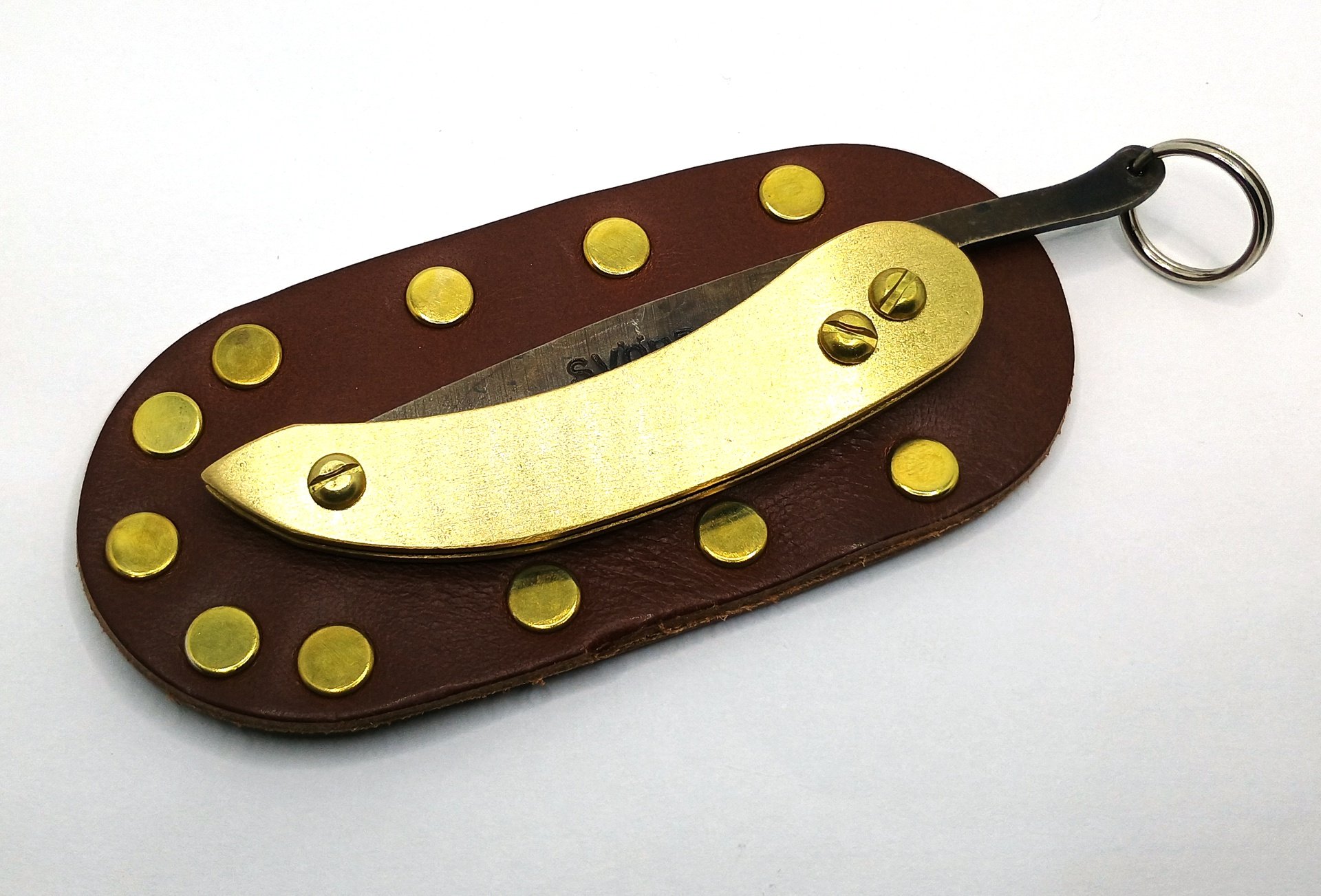
For the the price of admission you also get this leather sheath. And it is genuinely leather, albeit split grain. I have no doubt that it’s just as handmade as the knife is.
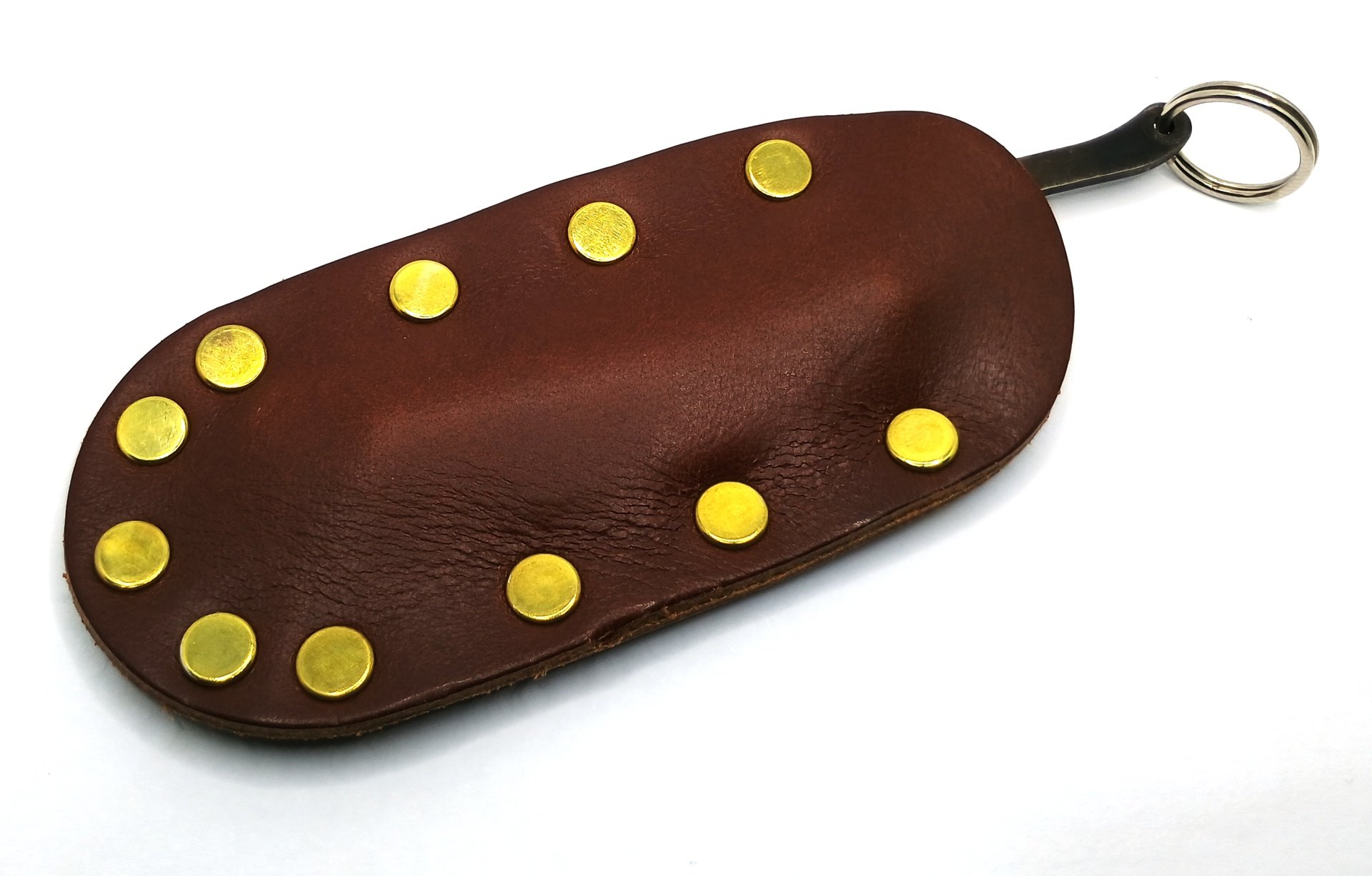
It’s a bit of a squeeze but it’ll conform to the shape of your knife over time. The tang is left sticking out along with its ring, if you leave it installed.
It’s not much, but it’d absolutely complete the ensemble along with your canvas messenger bag, designer beard wax, hemp beanie, and vintage flannel shirt.
The Inevitable Conclusion
I think there’s a place for a Svörd Peasant in every knife person’s collection. It’s not exactly cheap in this brass guise at about $32, but nor is it really unreasonably expensive for what you get. Especially considering its hand made nature, plus the sheath and all.
I have used the phrase probably one too many times referring to something as a warning from history. The Peasant is anything but. It’s not a warning; it’s a celebration. It’s the closest thing you’ll probably ever get your hands on absolute genesis without owning a museum. It’s a chance to hold a fragment of the thing from which, ultimately, everything else in this hobby sprung forth.
Maybe its two handle slabs aren’t quite technically identically shaped to each other. Maybe it’s got grinder marks on it, and it shows up with an uneven patina, and its blade will rub scuffs into the insides of the handles as you use it. For any cheap mass produced knife we’d decry this sort of thing to no end. We’d label it crap, and to hell with it, and declare it Temu garbage of the worst kind.
But what makes the Peasant different is that all of that is the point. Therein lies the charm; that’s what makes it special. It’s flawed, but intentionally so. And thus every one of them is in some tiny way unique compared to all the others as well. I would not at all be surprised to find, for example, that the parts from this one wouldn’t quite interchange with the parts of any others. And that’s something you never see anymore.
Maybe the Svörd Peasant’s real value is making you stop and look at every manufactured thing in a different way. Someone made this. Some one. A person. Not a factory, not a country, not a conglomerate, and if you choose to look at it hard enough, maybe not even a brand.
In more ways than one, then, it comes from a different time. And that’s where the magic is.
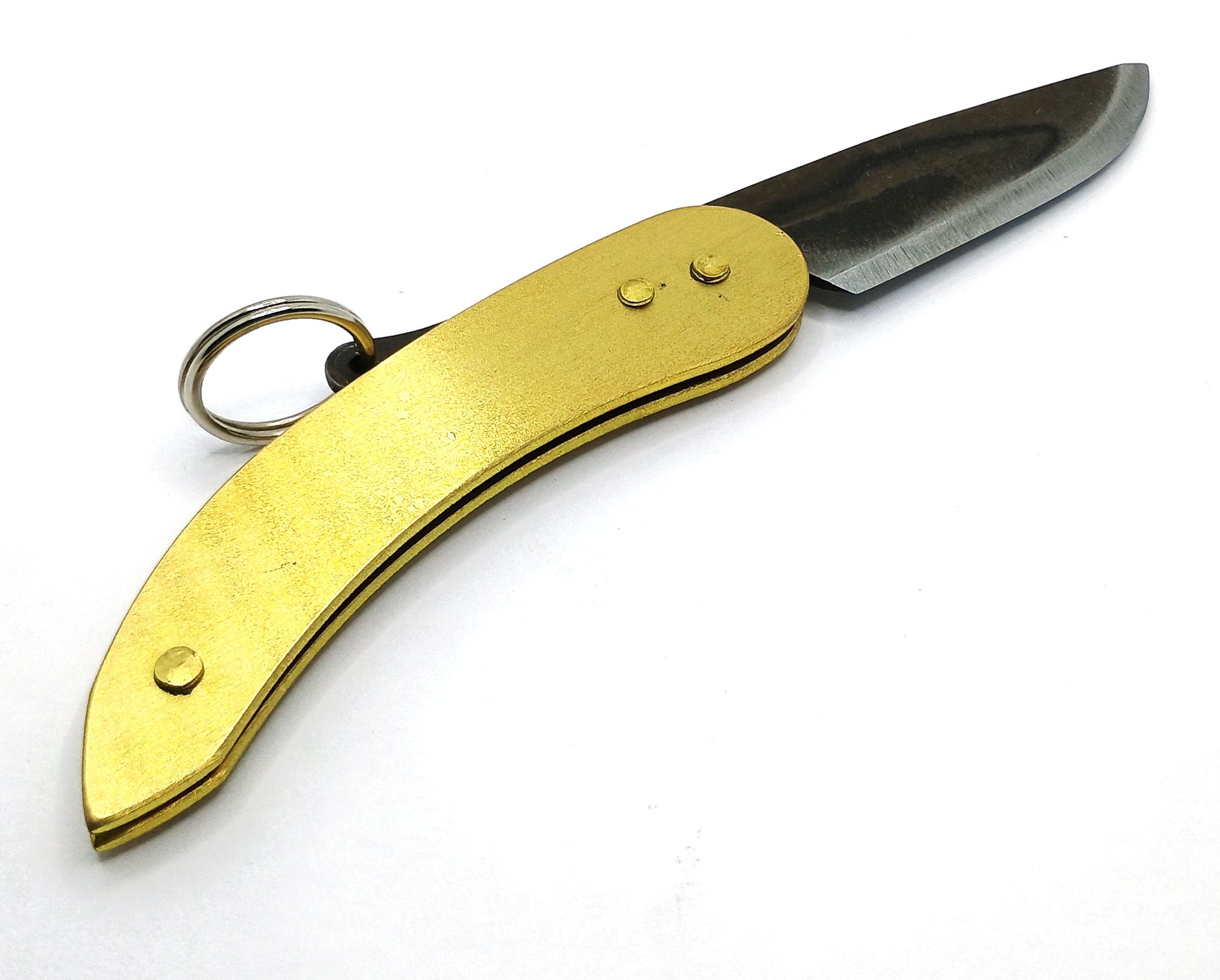
So see you later, alligator. Never change.


While I’d never EDC one because I don’t trust anything without locks going into my pockets, I’ve always thought tang grip knives were really neat, and are probably great for outdoorsy things. The mechanism is so simple that even if your handle breaks, with just a screwdriver and some patience you can affix the blade to just about any stick or piece of wood and still make decent use of it. I feel like these would make for good knives to tuck into an emergency kit.